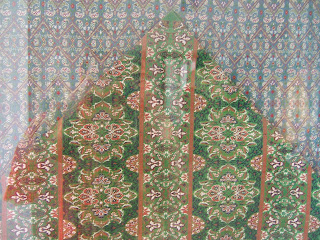 |
| Fabric-paper quilt collage, hand and machine embroidered 45x 52cm |
It's time for a reality check. What gave me the idea that I would change my old habits, my perennial twofold attitude towards reality, just because I said so?
I thought I had been posting a lot, or at least that I had lots of posts almost completed, ready to be published, complete with links and matching photographs, plenty of material that just needed a final push of a button (and/or will).
That, of course, had only happened in my head: yes, there are quite a few drafts, but nowhere as nearly ready as I thought they would be. Photos that I thought I had taken aren't there, planned layouts, titles, ideas, just gone, disappeared, never been.
So to help fill in the hiatus between fantasy and reality and start catching up again, I thought it would be a good idea to tell the story of my new Facebook Cover page, which is in fact the reproduction of my fabric-paper quilt titled 'Before the Fall'.

I made it, a couple of years ago, to my own deadline: I had the urgency to finish it before the autumn came, I think I made it by November, which is a good achievement by my standards. The title is a word play between the two meanings of Fall, as in both Autumn and an involuntary jump. Its other titles are 'The Indian Garden' and the "Blue Poppy" . It was born as a response to the Indian Garden that had been hosted by the British Museum (in collaboration with Kew Gardens) as part of a series of temporary thematic Gardens and Landscapes, often linked to exhibitions and events (in this case the wonderful 'Garden and Cosmos')
http://www.britishmuseum.org/the_museum/museum_in_london/indian_summer/garden_and_cosmos.aspx
THE POPPY OBSESSION
The need to make a collage/mixed media quilt about the Indian Garden had more than one reason: I did want to capture the ephemeral beauty of the blue poppy and make it a bit more permanent.
I wanted to share and prolong the joy that that garden had brought me: in a twisted sort of way, India was what had brought me to the British Museum in the first place and on the wake of an 'Indian Season' and Summer I was going to finish my (long) season there, as my job was due to terminate in the Autumn. I wanted to remind myself how ironic it was that when I finally wanted to stay I had to go (story of my life!)
It was about India, it featured the quite unique Blue Poppy and the possibility to catch its elusive sight (it didn't last long!) during lunch time, then there was the story of the Mango Tree that actually bore a fruit, right there in the middle of Bloomsbury, an unexpected auspicious present just like the Indian Garden on my 'doorsteps'

I loved several things, the Peepul and the Banyan trees, the spices and herbs, the humble French marigold, the Lotus pond, and so many others, but decided to focus mainly on the blue poppy, which had become a bit of an obsession and therefore had to be the 'focal point'. I have always loved poppies, their generous beauty, spread casually in the fields for everyone to enjoy: a 'democratic flower', deceptively fragile yet sturdy in its own way.
This poppy was particularly special too, so I set out studying the best way to reproduce it and do it in my medium of choice. Collages lend themselves to an instinctive approach, even though an overall plan must be present.
I wanted a lot of yellow/golden tones, to convey the sunny atmosphere (and as a nice contrasting background for the blue flower) reminiscent of India itself. Then the shape had to be right because this wasn't an ordinary poppy but at the same time simple and relatively easy to reproduce in fabric paper and be able to accommodate other materials as well as embroidery.
 |
| From the sketchbook |
A couple of common poppies had to be present too, because I couldn't resist the idea of a lovely red poppy being there as well, and I could use one that I had made some time before in machine embroidery with soluble fabric
This in turn offered me the opportunity to use some twisted wire (found on my way to the post-room) that was shaped exactly like a stem and that I was able to couch down with some silver metallic thread
Then there was the layering of images relating to India, mainly maps (but I also included some old Middlesex ordnance survey maps, somewhere just as exotic to me that I have come to call home) postal stamps and text. This was added in different media : ranging from proper collage of photocopied text glued down or cut-outs from food packaging, to special organza inkjet printed and attached to the background.
 |
| Detail showing the word Prema (Love) |
 |
| Detail showing an old Middlesex ordnance survey map |
 |
| Details showing an Indian stamp |
 |
| Indian stamp and food packaging |
 |
| Title printed on 'Extravaorganza' |
 |
| Detail of the blue poppy's centre with ripped velvet stitch |
 |
| Detail of layers made with different images of Delhi |
 |
| The marigold |

 |
| flower made with handmade nepali paper and varnished with acrylic wax |
 |
| Indian imagery |




 I have now found other USA Love stamps and I intend to expand, experiment and carry on making more Love stamps jewellery, including necklaces and bracelets, using more media and different jewellery techniques.
I have now found other USA Love stamps and I intend to expand, experiment and carry on making more Love stamps jewellery, including necklaces and bracelets, using more media and different jewellery techniques.





















































